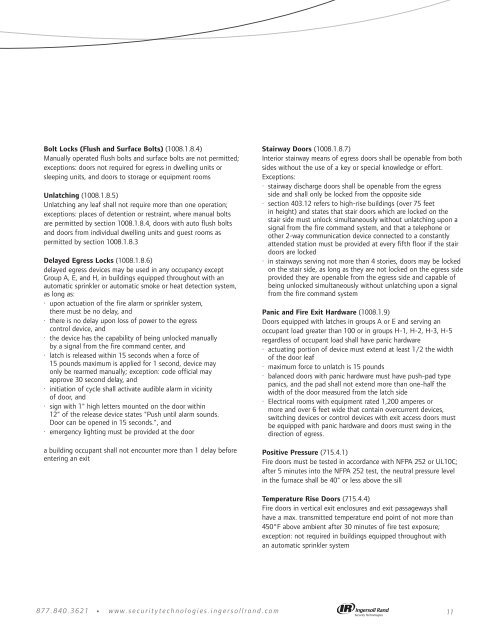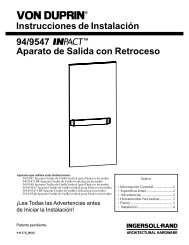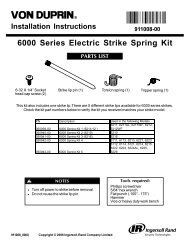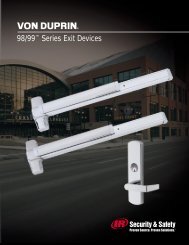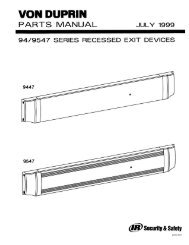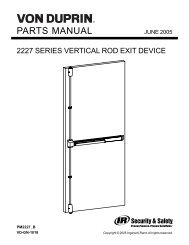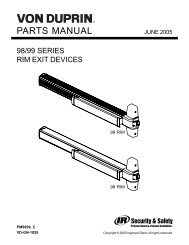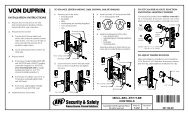Fire, Life Safety & Accessibility Codes - Von Duprin
Fire, Life Safety & Accessibility Codes - Von Duprin
Fire, Life Safety & Accessibility Codes - Von Duprin
You also want an ePaper? Increase the reach of your titles
YUMPU automatically turns print PDFs into web optimized ePapers that Google loves.
Bolt Locks (Flush and Surface Bolts) (1008.1.8.4)<br />
Manually operated flush bolts and surface bolts are not permitted;<br />
exceptions: doors not required for egress in dwelling units or<br />
sleeping units, and doors to storage or equipment rooms<br />
Unlatching (1008.1.8.5)<br />
Unlatching any leaf shall not require more than one operation;<br />
exceptions: places of detention or restraint, where manual bolts<br />
are permitted by section 1008.1.8.4, doors with auto flush bolts<br />
and doors from individual dwelling units and guest rooms as<br />
permitted by section 1008.1.8.3<br />
Delayed Egress Locks (1008.1.8.6)<br />
delayed egress devices may be used in any occupancy except<br />
Group A, E, and H, in buildings equipped throughout with an<br />
automatic sprinkler or automatic smoke or heat detection system,<br />
as long as:<br />
· upon actuation of the fire alarm or sprinkler system,<br />
there must be no delay, and<br />
· there is no delay upon loss of power to the egress<br />
control device, and<br />
· the device has the capability of being unlocked manually<br />
by a signal from the fire command center, and<br />
· latch is released within 15 seconds when a force of<br />
15 pounds maximum is applied for 1 second, device may<br />
only be rearmed manually; exception: code official may<br />
approve 30 second delay, and<br />
· initiation of cycle shall activate audible alarm in vicinity<br />
of door, and<br />
· sign with 1" high letters mounted on the door within<br />
12" of the release device states "Push until alarm sounds.<br />
Door can be opened in 15 seconds.", and<br />
· emergency lighting must be provided at the door<br />
a building occupant shall not encounter more than 1 delay before<br />
entering an exit<br />
877.840.3621 • www.securitytechnologies.ingersollrand.com<br />
Stairway Doors (1008.1.8.7)<br />
Interior stairway means of egress doors shall be openable from both<br />
sides without the use of a key or special knowledge or effort.<br />
Exceptions:<br />
· stairway discharge doors shall be openable from the egress<br />
side and shall only be locked from the opposite side<br />
· section 403.12 refers to high-rise buildings (over 75 feet<br />
in height) and states that stair doors which are locked on the<br />
stair side must unlock simultaneously without unlatching upon a<br />
signal from the fire command system, and that a telephone or<br />
other 2-way communication device connected to a constantly<br />
attended station must be provided at every fifth floor if the stair<br />
doors are locked<br />
· in stairways serving not more than 4 stories, doors may be locked<br />
on the stair side, as long as they are not locked on the egress side<br />
provided they are openable from the egress side and capable of<br />
being unlocked simultaneously without unlatching upon a signal<br />
from the fire command system<br />
Panic and <strong>Fire</strong> Exit Hardware (1008.1.9)<br />
Doors equipped with latches in groups A or E and serving an<br />
occupant load greater than 100 or in groups H-1, H-2, H-3, H-5<br />
regardless of occupant load shall have panic hardware<br />
· actuating portion of device must extend at least 1/2 the width<br />
of the door leaf<br />
· maximum force to unlatch is 15 pounds<br />
· balanced doors with panic hardware must have push-pad type<br />
panics, and the pad shall not extend more than one-half the<br />
width of the door measured from the latch side<br />
· Electrical rooms with equipment rated 1,200 amperes or<br />
more and over 6 feet wide that contain overcurrent devices,<br />
switching devices or control devices with exit access doors must<br />
be equipped with panic hardware and doors must swing in the<br />
direction of egress.<br />
Positive Pressure (715.4.1)<br />
<strong>Fire</strong> doors must be tested in accordance with NFPA 252 or UL10C;<br />
after 5 minutes into the NFPA 252 test, the neutral pressure level<br />
in the furnace shall be 40" or less above the sill<br />
Temperature Rise Doors (715.4.4)<br />
<strong>Fire</strong> doors in vertical exit enclosures and exit passageways shall<br />
have a max. transmitted temperature end point of not more than<br />
450°F above ambient after 30 minutes of fire test exposure;<br />
exception: not required in buildings equipped throughout with<br />
an automatic sprinkler system<br />
11


